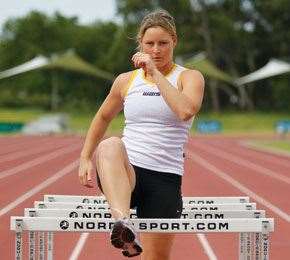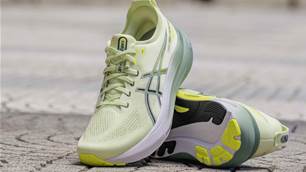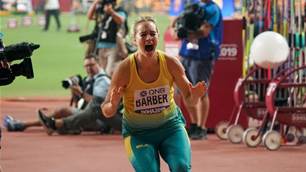Congrats to Aussie javelin thrower Kim Mickle for her World Champs silver medal! Here’s our “Training Day” on Kim from February 2012.
 Photos by Theron Kirkman Photo
Photos by Theron Kirkman Photo“Javelin is a highly technical event; it’s not just power and throwing strength. What you have to do is create a bit of leverage, and you learn to contort your body to achieve this. We call it the ‘C’ position; from my ankle all the way to my extended arm, the overall shape should look like the letter ‘C’. That’s called the power position. From there it’s a slingshot action over the top of my block leg to throw. When we have a run-up, we get more length and more depth from what our legs are doing because we have speed on our side. The stresses on the body can be huge.”
On track
“My work on the track really varies. It might involve some sprints or hurdles, or a series of plyos [plyometric exercises]. It depends on the time of year and where I am in my training cycle. Right now I am doing longer track work to get some fitness in my legs. This means a lot of 400s.
“Coming up to a major comp, I’ll do short and sharp sprints. Usually this means between 60m and 30m. Right now I am doing 100s. And it’s not about holding form. For me, it’s all about going flat out and getting that explosive power happening. That means going as hard and as fast as I can, but being a thrower, when I get to about the 80m mark, I start to get a little wobbly.
“Doing hurdles really helps my flexibility and coordination and works the hip flexors and glutes. You need to be coordinated to throw a javelin, and you have to be coordinated over hurdles or you’re going to stack it – I know all about that ... ”
Pitch perfect
“We throw a baseball around as a really good warm-up all year-round, but right now, because of my rehab, I’m doing a lot more time with the ball and glove. It’s really important to put something light in my hand and keep my arm cocking over with the throwing action. It helps maintain and improve that speed in my arm. You obviously don’t throw a javelin the same way you throw a baseball, but it’s purely to maintain that muscle memory of throwing hard and fast.
“The baseball drill is really good when you’re coming up to a major event, especially if you’ve been lifting really heavy weights. After big weights, sometimes the javelin feels really, really light – it weighs 600g. So it’s great to put a baseball in my hands, because after working with the baseball, the javelin feels a bit heavier again and you can get some real purchase on it.
Playing the weighting game
“I do a lot of different weights exercises in the gym. The pull-over is probably the most important exercise I do. Javelin requires a lot of lat (latissimus muscle) movement and shoulder flexibility. Doing this exercise puts the body under a lot of stress, especially with the weights we use. I have to have my coaches and spotters around me.
“My best lift for pullovers is about 65kg – and all to throw a 600g javelin! Still, it’s a great exercise for my sport, because it strengthens those muscles up for when I get to throw. But it’s not easy – when I do it, everyone always stops what they are doing in the gym and watches me.
“The bench press is probably the most impressive exercise I do. My best bench press is 97.5kg, which most of the blokes in the gym can’t do. My aim is to get to 100kg before I leave for London. I also do a lot of squats to streng-then up my legs for the block when I throw, and my best is 130kg.
“I do all the Olympic lifts. These are dynamic lifts, like cleans and snatches. My best clean is 95kg and my biggest snatch is 70. Those are heavy lifts, enough to probably win me a bit of respect if I’m ever around real weightlifters ... ”
Related Articles

I was not born to run

'Rio wasn't great': Aussie Javelin champion named Athlete of the Year













